SHOSTAKOVICH CONTEMPORARIES AND SOCIALIST REALISM
SOCIALIST REALISM

Gustave Courbet: The Stone Breakers (1849)
The paintings at right depict farmworkers, but these farmworkers are happy! Notice how the female working group at top right is boldly striding forth to work in the fields (Peaceful Fields!) and how the “Farmer With Pumpkins” is happily carrying her pumpkins. No sense of the oppressed worker here or the feeling of back-breaking manual labor that we see in the Courbet painting.

Salvadore Dali: The Anthropomorphic Cabinet 1936
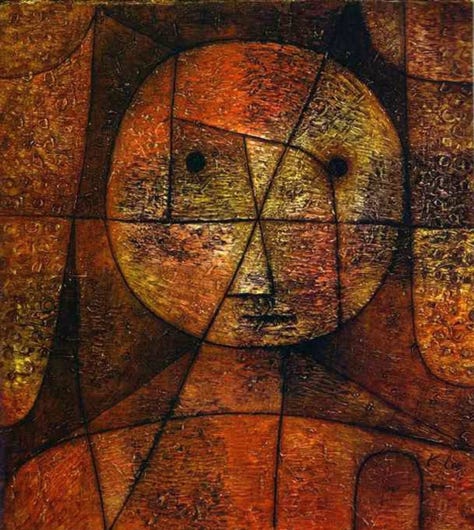
Paul Klee: Drawn One (1935)

Piet Mondrian: Picture II 1 with Yellow, Red and Blue (1936-43)
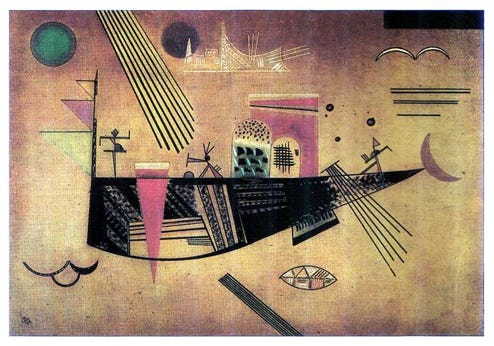
Wassily Kandinsky: Capricious (1930)
In 1920, Vladimir Lenin, first head of the Soviet government and a political theorist, wrote a resolution about proletarian culture. According to Lenin, art should be a development of the 'best models, traditions and results of the existing culture, from the point of view of the Marxist world outlook and the conditions of life and struggle of the proletariat'. In 1934, Maxim Gorky, an author and former friend of Lenin, spoke before the Soviet Writer's Congress. In his speech, Gorky attacked pre-revolutionary Russian and Western culture and literature and discussed the future of Soviet writing under Joseph Stalin, stating that the goal of future Soviet art and literature was to celebrate the 'new Soviet man', as exemplified in this painting by Valentyn Grekov:
Here are some other examples of Socialist Realism in the visual arts. Always bear in mind that the purpose of this art was to use realist styles to create highly optimistic depictions of Soviet life. Any pessimistic or critical element was banned, and this is the crucial difference between Socialist Realism and Social Realism. It was quite simply propaganda art. Consider the three paintings below-on the left we have a painting by the great French painter Gustave Courbet, The Stone Breakers, from 1849. Courbet was realist painter who depicted the real, back-breaking life of the common people. Note the torn shirt of the boy at the left and the fact that we don’t even see the faces of the two nameless workers. This is not an optimistic painting! And yet it is very realistic, showing real people. If we compare that with two paintings in the Socialist Realism style (at right), we can see a huge difference.

Mitrofan Grekov: Trumpeter and Standard Bearer (1934)

Here are some other examples of Socialist Realism art (right) and Western European art from the same time period (left). The Soviets considered the Western European art to be “formalist” and “decadent” bourgeoise art.

Alexander Laktionov: Visiting My Grandmother (1930)
CONTEMPORARIES
Socialist Realism in music demanded an absence of western “formalism” or diatonic non-conformity. The music had to be “understandable” to the working class and serve their interests, not be a form of expression for the composer. Music which was written as Socialist Realist music is largely forgotten as it was usually of a very low musical quality and served only as a platform for Socialist messaging. Many very great composers like Prokofiev and Shostakovich and others were forced to write in this style at times, often to survive. As noted Shostakovich scholar Laurel Fay has written in her fine biography Shostakovich: A Life, “The only musical art deemed worthy of the working classes, and thus the only music demanded by the Soviet state, was to be defined by its accessibility, tunefulness, stylistic traditionalism, and folk-inspired qualities. It was to be optimistic, aspiring to heroic exhilaration.”
The Soviet Writer's Congress of 1934 further defined the guiding principles behind socialist realism, which the Union of Soviet Socialist Republics formalized in a document titled 'On the Reconstruction of Literary and Art Organizations'.
According to the state, all forms of art-including music-should:
Be about and supportive of Soviet workers
Be free from abstractions
Idealize or romanticize everyday Soviet life
Promote the goals of the Communist Party
I offer below some examples of compositions by Shostakovich’s contemporaries and colleagues, who suffered under the same regime of Stalin and who, like Shostakovich, were hounded by the Soviet authorities from time to time if their music was veering towards “formalism”. Prokofiev, Khachaturian, and Kabalevsky, to name only the three most prominent composers working in the Soviet Union with Shostakovich from the mid-1930s on, all had to compose “official” works and also attempted to toe the line with regard to the requirements for music that have been mentioned above.

Andrei Mylnikov: In Peaceful Fields (1950)
Ilya Mashkov: Farmer With Pumpkins (1930)
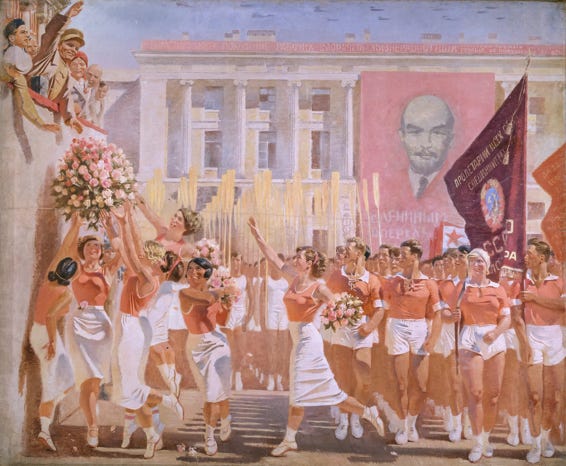
Alexander Samokhvalov: Sergei Kirov Reviews the Athletic Parade (1935)
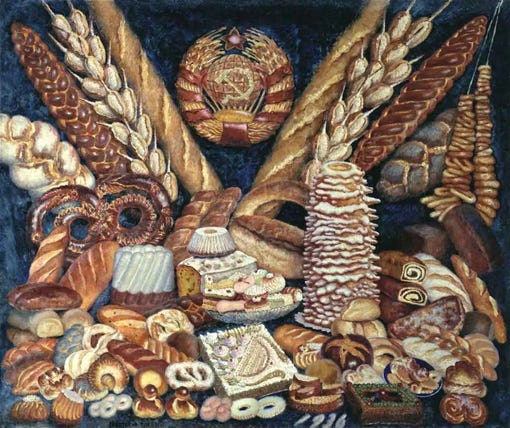
Ilya Mashov: Soviet Bread (1936)
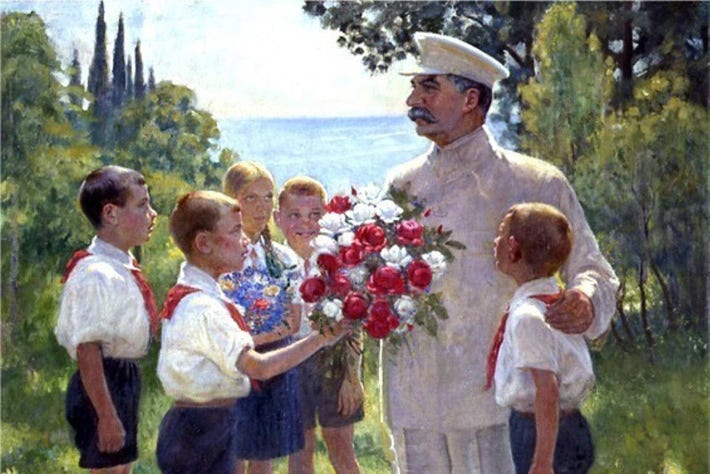
Boris Vladimirsky: Roses for Stalin (1949)
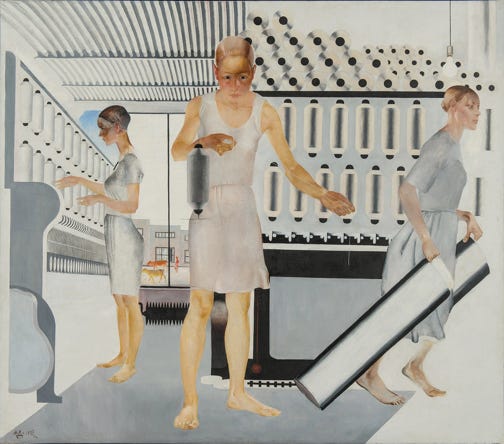
Aleksandr Deineka: Textile Workers (1927)
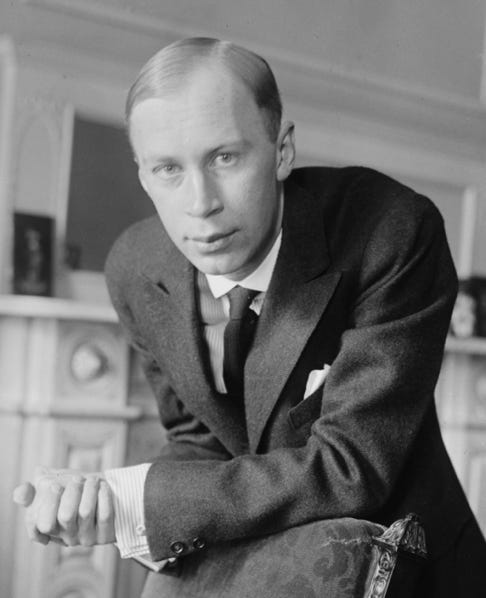
Sergei Prokofiev left Russia in 1918 and lived in the U.S., Germany, and France until 1936. In 1936 he moved with his family back to the Soviet Union, where he remained for the rest of his life. This was exactly the time that Shostakovich was denounced by the government in the “Chaos Instead of Music” article that referenced Lady Macbeth of the Mtsensk District. Many of Prokofiev’s greatest works would be written during his 17 last years in the Soviet Union (ironically, he died on the same day as Stalin in March 1953). These include Peter and the Wolf, Romeo and Juliet, Cinderella, Lieutenant Kije, War and Peace, Symphony no. 5, and many others. Also included are “official” works that he undertook for the government. One of these is Hail To Stalin (yes, you read that correctly!), composed in 1939. As you listen to this recording of it (I suggest listening to the entire 12-minute composition), ask yourself “Does this sound like the Prokofiev I know and love?”. It is a very interesting work. The first lines the chorus sings are:
Never before
Were the fields so green.
With unprecedented joy
The whole village is full.
Never before for us
Has life been so joyous.
Never before in our country,
Has the rye blossomed so.
Differently now, the sun
Shines upon the earth.
Surely the sun must have been
With Stalin in the Kremlin.
Socialist Realism music!!!

Audio Player
A much finer piece of music by Prokofiev is Peter and the Wolf, composed in 1936. This universally adored work has always been one of Prokofiev’s most popular compositions. It can also be considered to have certain characteristics of the Socialist Realism doctrine: easily accessible, optimistic (ending), straightforward harmonies, melodies that are unforgettable and have a folksy (in certain cases) tunefulness to them: music for the masses. This video production is simply outstanding: I really recommend it highly. Shown here are the final nine minutes of the work. Enjoy!!!

Another famous work that is sometimes considered “Socialist Realism” is Shostakovich’s 5th Symphony, composed in 1937 and which is often considered the composer’s “re-entry” into the official musical world after his denunciation in 1936. In this symphony the composer effects a 180 degree turn from the music of the Symphony No. 4, which was completed in 1936. The music is accessible, ends in triumph (although there is controversy over this), and was immediately popular at its first hearing in 1937. Offered here are the final moments (the triumphal part) of the symphony. According to Testimony, the book (allegedly) dictated to Solomon Volkov by Shostakovich, this final rejoicing “is forced, created under threat, as in Boris Godunov. It's as if someone were beating you with a stick and saying, "Your business is rejoicing, your business is rejoicing", and you rise, shaky, and go marching off, muttering, "Our business is rejoicing, our business is rejoicing."

Audio Player
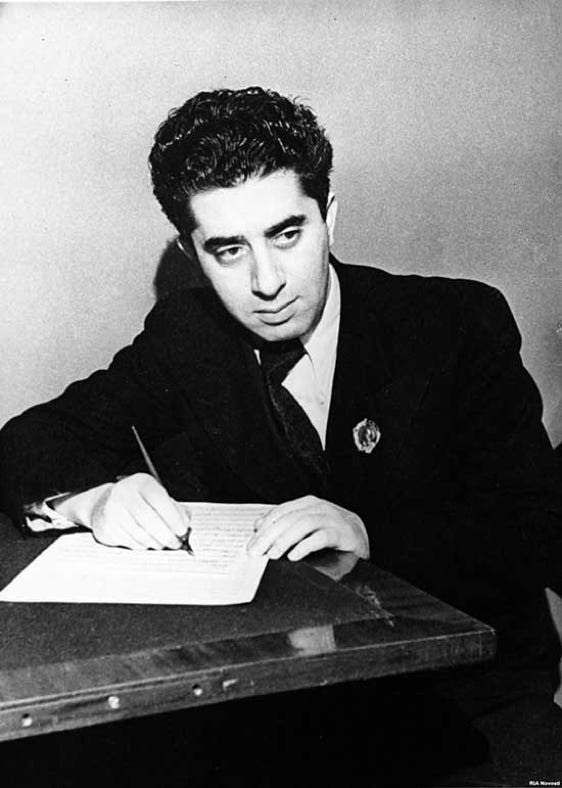
Aram Khachaturian (1903-1978) was a Soviet Armenian composer and conductor, and he is considered one of the leading Soviet composers of the 20th Century. Khachaturian made extensive use of Armenian folk music in his works. He was among the handful of composers who were targeted by the Soviet authorities in the infamous Zhdanov Decree of 1948. Like Prokofiev and Shostakovich, the music of Khachaturian can be divided into two categories: 1) music accessible to the masses, or what Prokofiev called “light-serious” music, i.e. music that at least paid some attention to Socialist Realism dictates, and 2) an entirely different type of music of a much more progressive, ‘modern’ approach, which often had to be kept under lock and key until different times arrived in the USSR, which DID occur after the death of Stalin in 1953. Here is the final movement of the Violin Concerto by Khachaturian: tuneful, virtuosic, inspired writing that is easily accessible as well.

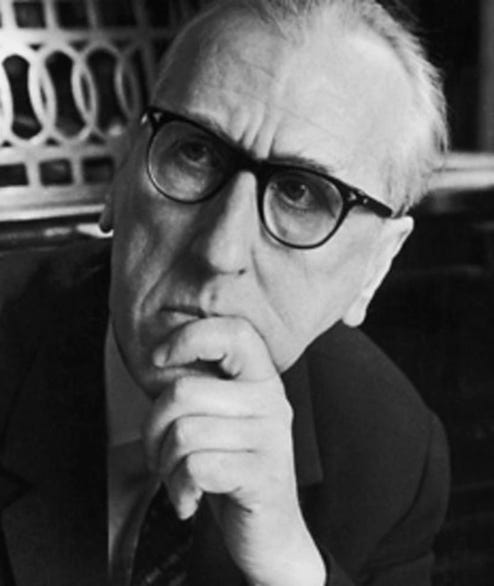
Another leading composer who was contemporary with Shostakovich was Dmitry Kabalevsky (1904-1987). Kabalevsky was instrumental in setting up the Union of Soviet Composers in Moscow and remained one of its leading figures during his long lifetime. He was a prolific composer of piano music and chamber music, as well as composing four symphonies and concertos for piano (4), cello (2), and violin (1). The Overture to his opera Colas Breugnon (1938) is a very popular orchestral tour-de-force lasting all of four minutes and is performed here by the symphony orchestra from Maestro E’s alma mater, USC. Go Trojans!